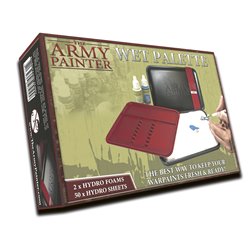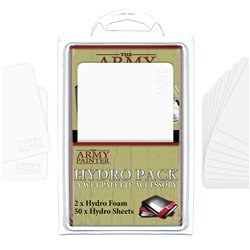Creating a revetment for a World War II aircraft dispersal can add a realistic touch to a diorama. A revetment is a...
No products
Product successfully added to your shopping cart
There are 0 items in your cart. There is 1 item in your cart.
Search Tips
What are the advantages of a wet palette when painting models?
A wet palette offers several advantages when painting models and if you've ever struggled with paint drying too quickly or inconsistencies in texture, it's worth considering adding one to your toolkit. Whether you're working on Warhammer miniatures, D&D figures or model railways models, the benefits are clear. Let’s explore how a wet palette can make a difference to your painting process.
One of the primary advantages of using a wet palette is that it keeps your paints from drying out too quickly. Acrylic paints, which are commonly used for miniature painting, tend to dry fast when exposed to air. This can be particularly frustrating when you're working on intricate details and need time to blend or layer your colours. A wet palette keeps the paint moist by using a combination of water and a semi-permeable membrane, allowing you to maintain consistency and avoid wastage.
Additionally, a wet palette helps with blending and achieving smooth transitions between colours. When paints stay wet for longer, it gives you more control over your blending techniques, making it easier to achieve gradients or subtle shading. If you're a fan of techniques like glazing or wet blending, the wet palette becomes an invaluable tool as it keeps your colours workable for much longer compared to a traditional palette.
Another advantage is how a wet palette enhances the mixing of custom colours. Mixing paints can be tricky, especially when your paint dries before you've had a chance to apply it. With a wet palette, you can mix and store custom colours for longer periods. This means that you can return to a mix after a break without needing to start again from scratch, which is particularly useful when working on a large or multi-session project.
If you're someone who paints over several days or even weeks, the wet palette can save you a lot of time. Instead of having to remix your colours every session, your paint remains usable on the palette for days or even longer if stored properly. This can help with consistency throughout your project, ensuring the same colour mixes are available as needed.
Finally, it's a more cost-effective option in the long run. Because the wet palette prevents paint from drying out prematurely, you'll end up using less paint overall, saving money on replenishing your stock. While the initial cost of a wet palette might seem like an investment, especially if you opt for a professional-grade one, it pays off by reducing the amount of paint you waste.
In summary, a wet palette is a valuable tool for any miniature painter, offering extended working time, better control over blends and saving on paint. If you haven't yet tried one, it’s worth experimenting with to see how it can improve your painting sessions. Whether you're a beginner or an experienced hobbyist, the wet palette can enhance your skills and make the painting process more enjoyable.
Click here to receive the tips weekly in your mailbox. You can unsubscribe at any time.









